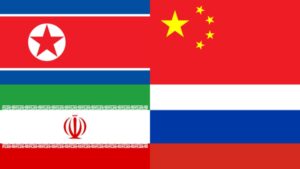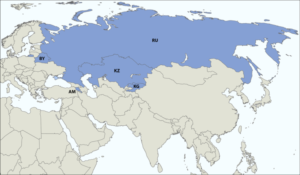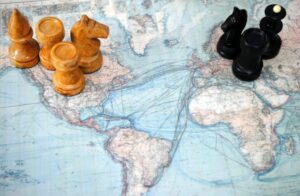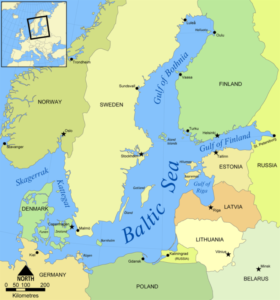- The COVID-19 pandemic has exposed the fragility of global market interdependence;
- As political risks increased during the war in Ukraine, the negative aspects of the interconnected nature of global trade were once again highlighted.
- Despite the costs, countries are opting for reshoring, in the path of economic nationalism and in pursuit of strategic sovereignty.
In the wake of the COVID-19 pandemic crisis and throughout the war in Ukraine, the risks associated with the interconnected nature of global trade were exposed. The great dependence on foreign products, especially those considered indispensable – such as natural gas, raw materials, microchips, or food – is harmful to dependent countries.
As observed throughout 2022, there is the possibility of interruption of production or supply by producing countries due to war or economic sanctions, leaving importing countries in a chaotic situation depending on the importance of the missing product.
That said, it is clear that the shock caused by the war goes far beyond Russia and Ukraine, as geopolitical risks have increased globally. So, with disruptions in supply chains, rising prices and shortages coming together, a process known as de-globalization is taking place.

What is Deglobalization, Deglobalization or “Slowbalization”
Deglobalization is a process of decreasing interdependence and integration between nation-states, and the term is widely used to describe periods in history when economic trade and investment between countries declines.
The concept is the opposite of the more well-known globalization, in which countries become increasingly integrated and interdependent over time. In globalization, the economic, commercial, social, technological, cultural and political dimensions are discussed, however, a large part of the work that was carried out in the study of deglobalization refers to the field of international economics.
The best examples of world deglobalization were the period known as “The Great Depression” after the New York Stock Exchange crash in 1929, and the period known as “The Great Collapse of Commerce”, a consequence of the 2008 financial crisis.
The two main phases of deglobalization are not the same. In the 1930s, democracies stopped supporting free trade and deglobalization resulted in the creation of self-sufficient trade blocs through rigid tariffs on imports from outside their circle, producing an intense regionalization of trade.
With the end of the Cold War, there was a quest for more globalization. The creation of the World Trade Organization in 1995 played a key role in encouraging international trade, increasing economic interdependence between countries. It was believed that greater economic interdependence would bring peace, as if two countries depended on each other, they would be less likely to enter into armed conflict against each other.
However, throughout history we have been able to observe that economic interdependence has not been an impeding factor in war, see World War II and the Russian invasion of Ukraine.
Like globalization, economic deglobalization can be measured in different ways that center around the following main economic flows:
- Goods and services, measured through exports and imports;
- Work/people, measured through the net migration rate, which is the difference between the number of people entering and leaving a country during the year;
- Capital, measured by direct investment into or out of the country using the ratio of national or per capita income;
- Average tariffs and border restrictions on work;
- Capital controls, including restrictions on foreign direct investment or foreign direct investment.
Difference between Offshoring, Reshoring and Nearshoring of production chains
The production chain, in general, works as if it were a chain from the extraction and handling of the raw material to the transformation of the raw material into a product, and later, its distribution.
The stages of the production chain are integrated and carried out by different units (or countries) that interact along the entire chain of production processes, with the aim of producing goods and services for the market.
The production chain encompasses both consumer goods – purchased by the final consumer – and production goods (raw material) and capital goods (equipment and goods necessary for the production of other goods or services). However, each company or country chooses how it will structure its production and the main ways are:
- Offshoring – is when the producer distributes some of its vital functions abroad to streamline operations and lower costs. Typically, this is done in conjunction with a third-party service provider operating in a country with a significantly lower cost of living. The difference in wages between the chosen country, usually located on another continent, and his own country allows the producer to save capital on one of his most significant overhead expenses, such as wages.
- Reshoring – is when the producer takes the parts of his production chain that were previously offshore, back to his home country, as offshore saves capital but can cause a drop in service and product quality. However, this form of production can become more expensive due to the need to hire permanent workers and their costs.
- Nearshoring – is when the producer unites the benefits of offshoring and reshoring at once, deploying its production chain in a country close to its borders, mitigating the possible cultural, distance and geopolitical differences of offshoring and still saving capital with outsourcing employees, instead of hiring permanent workers as in reshoring.
All models have positive and negative aspects, but it is important to emphasize that, despite favorable costs, when a country or company decides to carry out part of its production abroad, it will be assuming the risks of geopolitical influence on its business.
What is Economic Nationalism and Greater Strategic Sovereignty
Economic nationalism is an ideology that favors state interventionism, that is, when the state must intervene in the country’s economy with policies of domestic control of the economy, work and capital accumulation.
In addition, if necessary, the State can impose tariffs and other restrictions on the movement of capital and goods, and even labor. The main belief of economic nationalism is that the economy should serve nationalist goals, that is, it should promote the interests of the nation, in pursuit of the country’s sovereignty.
Strategic sovereignty, which can be achieved through economic nationalism and other measures, is defined as the ability of a state to pursue its national interests and adopt the foreign policy of its choice without depending on other countries.
Taking the debate on European strategic sovereignty as an example, it is important to distinguish the three specific terms, which together lead a country (or a bloc) to the level and ambition of strategic sovereignty:
- The capacity to act – which refers to the political and material conditions for action in foreign policy, in the field of security and defense.
- Strategic autonomy – which refers to the ability to define your own priorities, make decisions and implement them, going beyond the mere ability to act.
- Strategic sovereignty – which refers to the ability to jointly exercise sovereignty in all areas of state policies, ie the political concept of sovereignty implies a common political authority. This is the most ambitious level in the pursuit of State sovereignty.
Furthermore, in addition to military security, the ambition for strategic sovereignty must also include all relevant policy areas of the State for its own protection, in line with geopolitical conditions. Such as autonomous trade policy, financial sovereignty, reducing dependence on imports and technological sovereignty.
Both the Pandemic and the war in Ukraine have led to more economic nationalism, and deglobalization is one of the consequences of this process.
How the Covid Pandemic and the War in Ukraine led to a greater search for greater resilience in production chains.
The COVID-19 pandemic has exposed global market weaknesses, especially in countries where economic activities have been replaced by financial markets, and in countries that have struggled to obtain sufficient supplies to meet the basic needs of their population.
Shortly after the “end” of the pandemic, the war in Ukraine suddenly increased geopolitical risks, once again highlighting the risks associated with the interconnected nature of global trade.
These risks are evident because dependence on foreign input producers can lead to interruption of supply to dependent countries, when countries of origin become unfeasible.
Therefore, as geopolitical risks became evident in several countries due to the war, States began to review the structure of their supply chains, in search of greater resilience in their production chains, so that they would no longer be at the mercy of others. countries.
In this way, governments that invest in production chains in their own territory, as in reshoring, may eventually no longer depend exclusively on other countries and thus ensure the basic needs of the State and the population.
Main examples of Economic Nationalism by the great powers in search of Strategic Sovereignty
The greatest examples of the search for greater resilience in production chains, through economic nationalism, are the following projects:
- US CHIPS Act
- United States Inflation Reduction Act
- EU CHIPS Act of the European Union
- Made in China 2025 from Beijing
The CHIPS Act is a US federal statute signed into law by President Joe Biden in August 2022. The law provides approximately $280 billion in new funding to boost domestic research and semiconductor manufacturing in the United States.
This project gained traction during the worst days of the coronavirus pandemic – when global semiconductor shortages disrupted auto, electronics and even appliance manufacturing – with the aim of reducing supply chain exposure to foreign shocks.
The Inflation Reduction Act, created in 2022 by the US government, will invest approximately $369 billion in energy security and climate change programs through 2032.
The EU CHIPS Act is the European version of the bill, which will strengthen Europe’s competitiveness and resilience in semiconductor technologies and applications and help achieve the digital and green transition, strengthening the continent’s technology.
With the European Chips Act, the EU aims to address semiconductor shortages and strengthen Europe’s technological leadership.
The union will mobilize more than €43 billion in public and private investment and define measures to prepare, anticipate and respond quickly to any future supply chain disruptions, in conjunction with Member States and its international partners.
The Made in China 2025 project, is a national and political strategic plan where China intends to move away from being the “factory of the world”, as a producer of cheap low-tech goods facilitated by low labor costs and with advantages in the supply chain. , to become a more technology-intensive powerhouse.
The country aims to achieve independence from foreign suppliers, encouraging increased production of high technology products and services, focusing on its semiconductor industry.
The geopolitical consequences of a retreat or mitigation in globalization
World deglobalization or the stagnation of globalization could strengthen the great powers that have the capacity to produce and develop high technology domestically in relation to the rest of the world, because in addition to having high technologies, they will also have their own production chain, reducing external dependence on other supplier countries.
With the completion of the Chinese project “Made in China 2025”, the country will indeed be considered one of the world’s greatest powers, equal to the United States and equivalent to the European Union. However, if China fails to carry out the project, it could weaken itself politically and economically.
On the other hand, the greater autonomy of the great powers that own the technological productive chains, could reduce the transfer of technology to emerging countries, such as India, Brazil, Turkey, Mexico and Indonesia. Further emphasizing economic nationalism, regionalism and the stagnation of globalization.
If this process develops as predicted above, there will be a strengthening of the great world powers and a proportional weakening of emerging and less developed countries that do not have the capacity to be self-sufficient.





















Be First to Comment